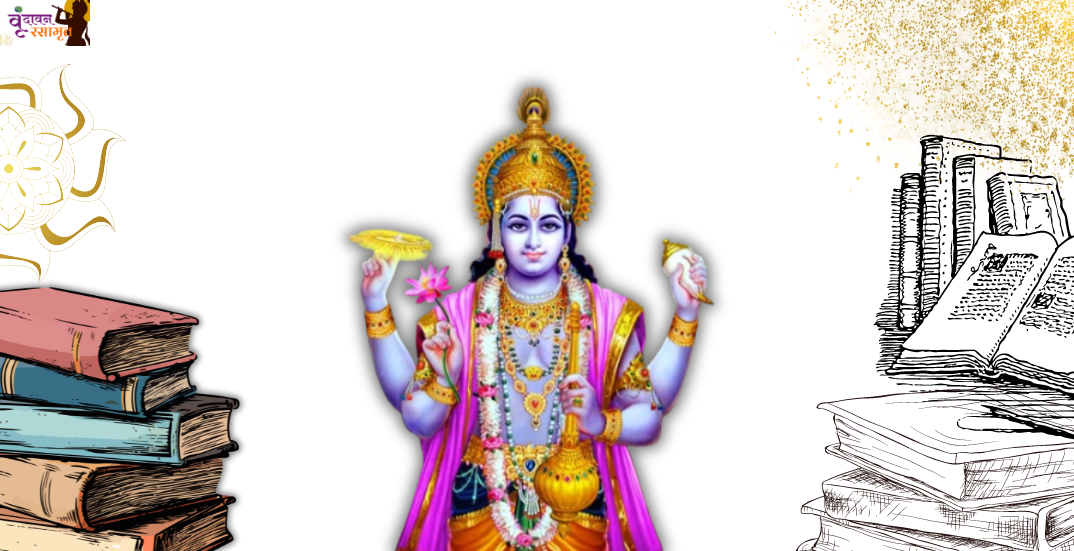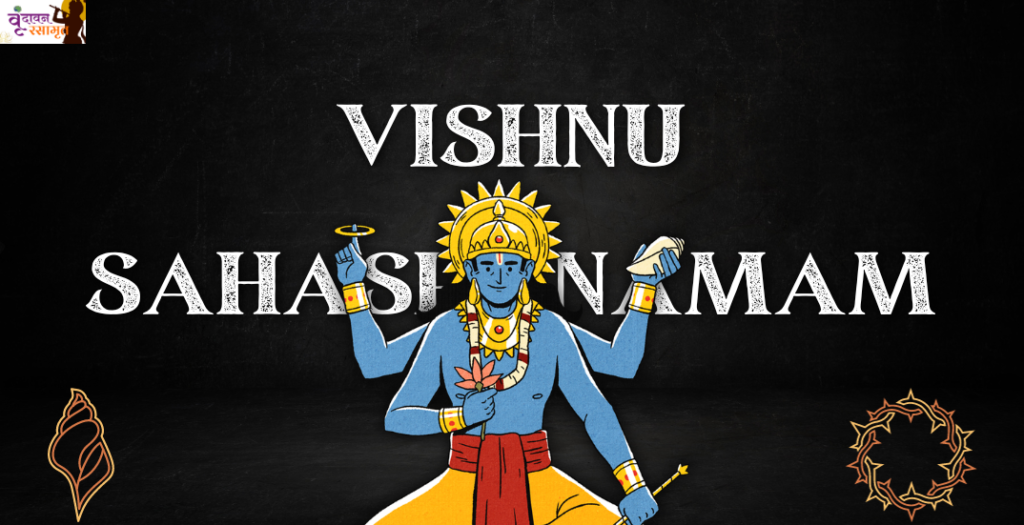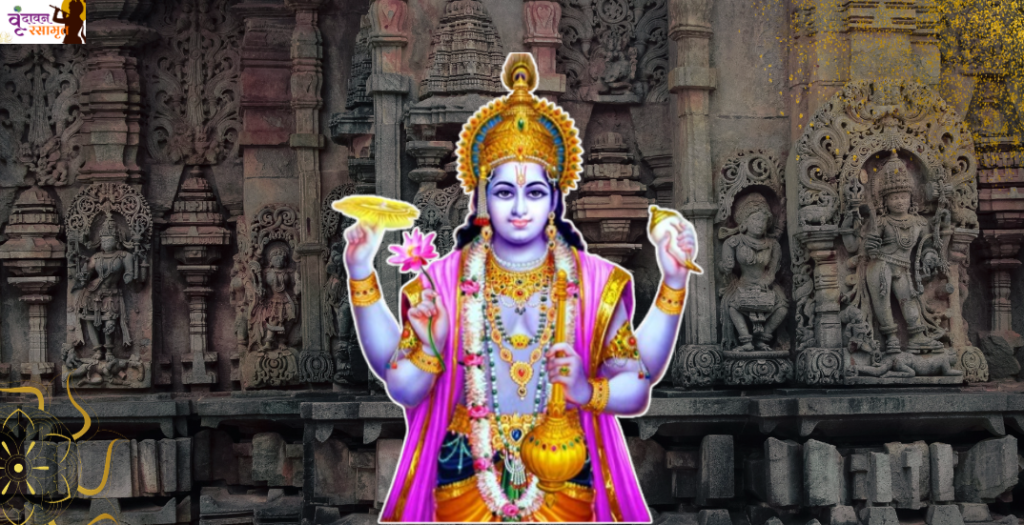In today’s blog we will know what is the logic behind Vishnu Sahasranamam? What’s the secret? Why is this so important in Sanatan culture? Will give you answers to all these questions.
We are making a series of articles on the subject of Vishnu Sahasranamam, of which this is the third article. Read the previous article by clicking on the link given below:
Link: https://vrindavanrasamrit.in/vishnu-sahasranamam/a-beginners-guide/
Now let’s move on to know the mythology behind Vishnu Sahasranama.
Introduction to the mythological roots of Vishnu Sahasranamam
First of all let us know what is Vishnu Sahasranamam? In simple language, these are 1000 names of Vishnu. Vishnu is known as the governing god in Sanatan culture. Whenever there is any disturbance in the universe, whenever there is any disturbance in the operation of the universe, then Lord Shri Hari Narayan removes those objections. Meaning, God is the sustainer of the universe.
The recitation of Vishnu Sahasranamam and its greatness is narrated by grandfather Shri Bhishma to Maharaja Yudhishthir after the war of Mahabharata.
This mention comes in the 149th chapter of Anushasanaparva of the epic Mahabharata.
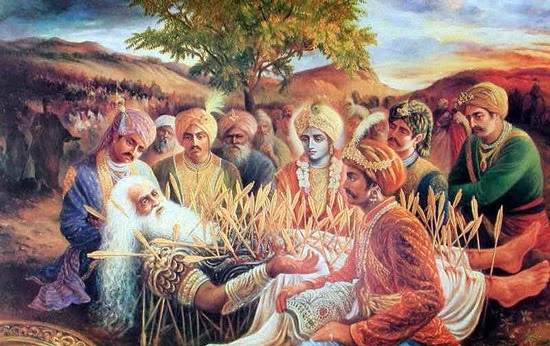
The simple secret behind the 1000 names of Lord Vishnu in Vishnu Sahasranamam is that each name describes the qualities of Lord Shri Vishnu. Every name reflects the qualities of Vishnu.
In this chapter, the most profound secrets about Vishnu Sahasranamam have been revealed by Bhishma. Like who should do this lesson, when is it appropriate to do it, what benefits do we get from it, etc.
Mythological Narratives in Vishnu Sahasranamam
Thousand names of Lord Vishnu, is not just a litany of divine epithets but a gateway to myriad mythological narratives. Each name unveils a story, often lesser-known, that embodies Vishnu’s essence – as a preserver, protector, and a beacon of dharma (righteousness).
the name ‘Trivikrama’ refers to Vishnu’s Vamana avatar, where he manifests as a dwarf Brahmin and conquers the three worlds in just three steps, emphasizing the theme of humility and the cosmic scale of divinity. Another intriguing name, ‘Shridhara’, meaning the bearer of fortune, alludes to Vishnu’s role as the upholder of prosperity and cosmic order.
These narratives serve a dual purpose. They recount Vishnu’s divine play (leela) and incarnations (avatars), each addressing a different cosmic crisis, while also illustrating moral and ethical ideals. Names like ‘Narasimha’, the half-man half-lion avatar, speak of his fierce protection of devotees, asserting the triumph of faith over arrogance.
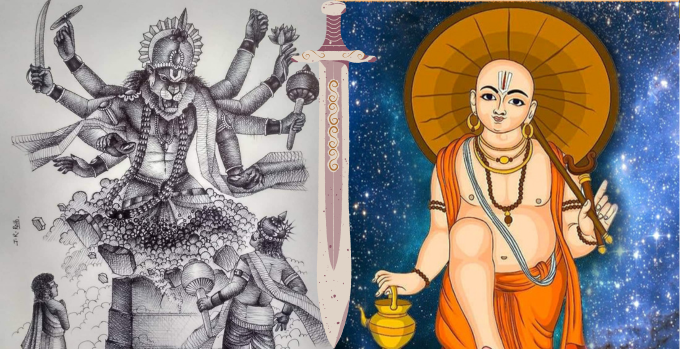
Such stories woven into each name are not just mythological accounts but symbolic representations of Vishnu’s multifaceted character. They emphasize his accessibility to devotees, readiness to restore cosmic balance, and the vast spectrum of his divine interventions. The Vishnu Sahasranamam, through these narratives, thus offers a profound spiritual exploration, revealing the depth and diversity of Vishnu’s role in the Hindu cosmic vision.
The Role of Vishnu Sahasranamam in Epic Tales
In the Ramayana, Vishnu incarnates as Lord Rama, a central figure whose life and journey are emblematic of dharma (righteousness) and moral rectitude. Names in the Sahasranamam like ‘Raghava’ and ‘Dasharathinanda’, directly reference Rama’s lineage and paternal connection, encapsulating his role as a dutiful prince and a divine avatar. Rama’s embodiment of idealism, be it in the role of a son, a king, or a warrior, reflects Vishnu’s commitment to maintaining cosmic order and righteousness.
Similarly, in the Mahabharata, Vishnu’s avatar as Krishna is pivotal. Krishna’s guidance in the form of the Bhagavad Gita, a spiritual and philosophical discourse given to the warrior Arjuna, is a significant element in the epic. Names like ‘Vasudeva’ (son of Vasudeva) and ‘Hrishikesha’ (master of the senses) in the Sahasranamam, are direct allusions to Krishna’s divine wisdom and his role as a guide and charioteer in the epic battle of Kurukshetra.
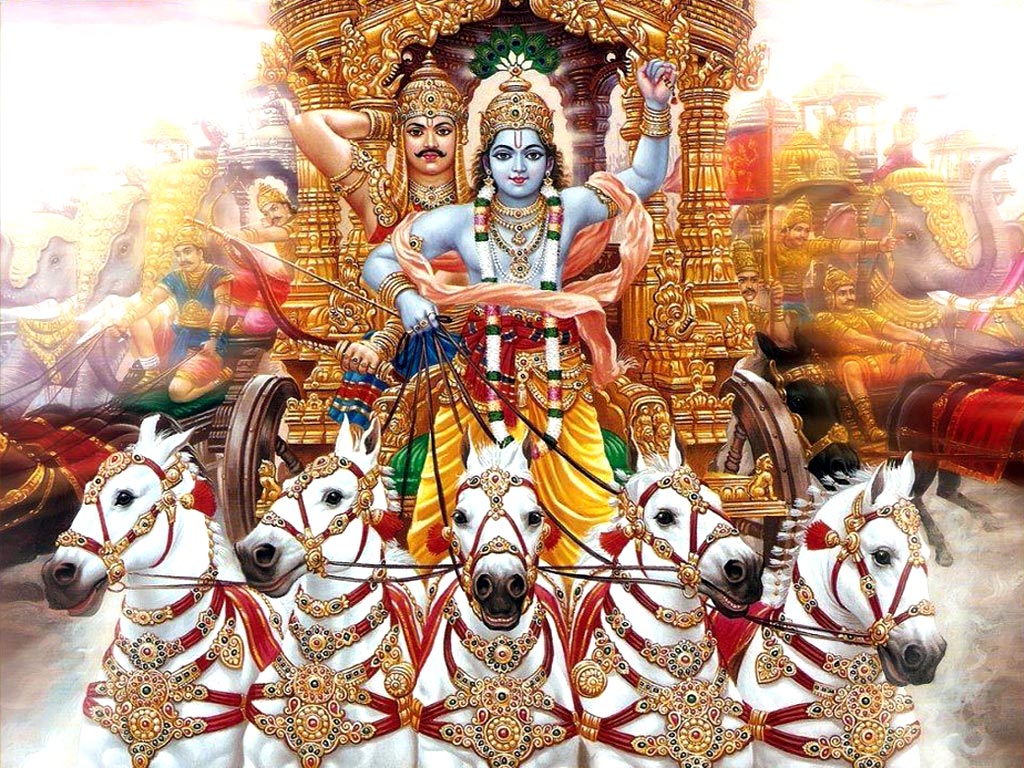
Moreover, the Vishnu Sahasranamam itself finds its origin in the Mahabharata, narrated by Bhishma, one of the great sages, as he lay on his bed of arrows. This context highlights the text’s significance as a reservoir of spiritual knowledge and a guide to righteous living, rooted in the rich tapestry of these epic tales.
Through these connections, the Vishnu Sahasranamam not only reinforces the mythological narratives of Vishnu’s avatars but also serves as a spiritual link to the profound philosophical and ethical teachings embedded in the Ramayana and Mahabharata.
Legends and Symbolism in Vishnu Sahasranamam
Each name, often rooted in a legend, carries profound symbolic meanings that collectively contribute to understanding the multi-dimensional nature of Vishnu.
One of the names, ‘Padmanabha’ (having the lotus navel), is emblematic. From Vishnu’s navel blooms a lotus, from which Brahma, the creator god, emerges. This symbolizes the cosmic origin and the interconnectedness of creation, preservation, and regeneration, central themes in Hindu cosmology. It reflects Vishnu’s role as the sustainer, from whom the universe emanates and into whom it ultimately dissolves.
Another significant name is ‘Hrishikesha’, meaning the master of the senses. This represents Vishnu’s control over mind and matter, an essential quality for attaining moksha (liberation). It also reflects his role in guiding the senses of his devotees towards the path of righteousness, as exemplified in the Bhagavad Gita, where Krishna (an avatar of Vishnu) imparts wisdom to Arjuna.
Names like ‘Narasimha’ (man-lion) and ‘Vamana’ (dwarf) signify Vishnu’s avatars, each with a distinct purpose. Narasimha’s fierce form, which vanquishes the demon Hiranyakashipu, symbolizes the triumph of good over evil, faith over arrogance. Vamana, on the other hand, represents the cosmic balance and the subversion of ego and power, as he humbles the king Bali.
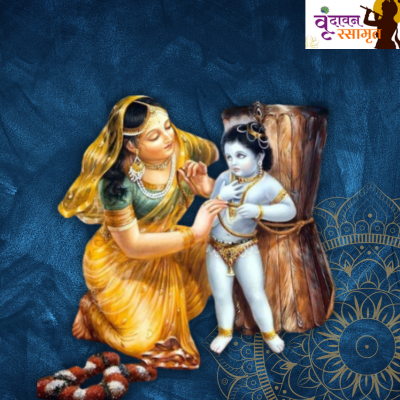
The name ‘Damodara’, associated with Krishna’s childhood, where his mother ties him with a rope (dam) around his waist (udara), symbolizes the boundless being bound by love and devotion. It illustrates Vishnu’s accessibility and responsiveness to pure devotion, irrespective of his cosmic stature.
These legends and symbols in the Vishnu Sahasranamam serve a dual purpose. They narrate Vishnu’s divine play and interventions, manifesting his various aspects, while also imparting profound philosophical insights.
Vishnu Sahasranamam: A Gateway to Mythological Wisdom
This text is a masterful amalgamation of storytelling and spirituality, where each name encapsulates a narrative that holds deep spiritual and moral significance.
For instance, the name ‘Hari’, often associated with Vishnu’s ability to remove sin and suffering, connects to numerous tales of Vishnu’s intervention to restore dharma (righteousness) in the universe.
Similarly, names like ‘Kesava’ (slayer of the demon Kesi) and ‘Govinda’ (protector of cows and by extension, life) hark back to tales of Krishna, an avatar of Vishnu, and his divine play on Earth.
Storytelling, in the context of the Vishnu Sahasranamam, serves as a powerful tool for preserving and imparting spiritual teachings.
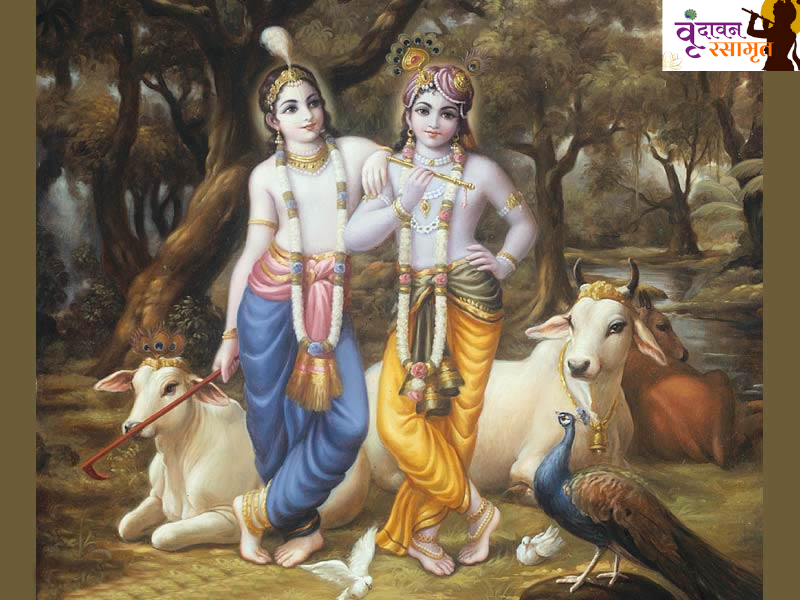
These stories, often passed down through generations, are not mere entertainment but vehicles of profound wisdom, teaching values such as devotion, morality, and the importance of balance in the universe.
They make the abstract concepts of divinity and spirituality tangible and accessible, allowing devotees to understand and internalize these concepts through familiar narratives.
In essence, the Vishnu Sahasranamam is not just a recitation of divine names but a comprehensive spiritual journey through the vast expanse of Hindu mythology, offering insights into the nature of the divine and the cosmic principles governing life.
It stands as a testament to the power of storytelling in preserving and disseminating spiritual wisdom.
Conclusion
In conclusion, our exploration of the Vishnu Sahasranamam in this third article of our series offers a rich tapestry of insights into the profound mythological and spiritual significance of these 1000 names of Lord Vishnu.
As we delve into the legends and symbolism enshrined within each name, we not only revisit the pivotal roles Vishnu plays in the Ramayana and Mahabharata but also uncover the deep moral and ethical teachings inherent in these tales.
We thank you for joining us on this enlightening journey through the mythological roots of the Vishnu Sahasranamam. Your engagement and curiosity make this exploration all the more enriching.
We encourage you to continue delving into the profound wisdom of Sanatan culture and invite you to read more such articles on Vrindavanrasamrit.in. Here, you’ll find a wealth of resources that will further illuminate the diverse aspects of Hindu mythology and spirituality, enriching your understanding and offering a pathway to inner peace and enlightenment.

